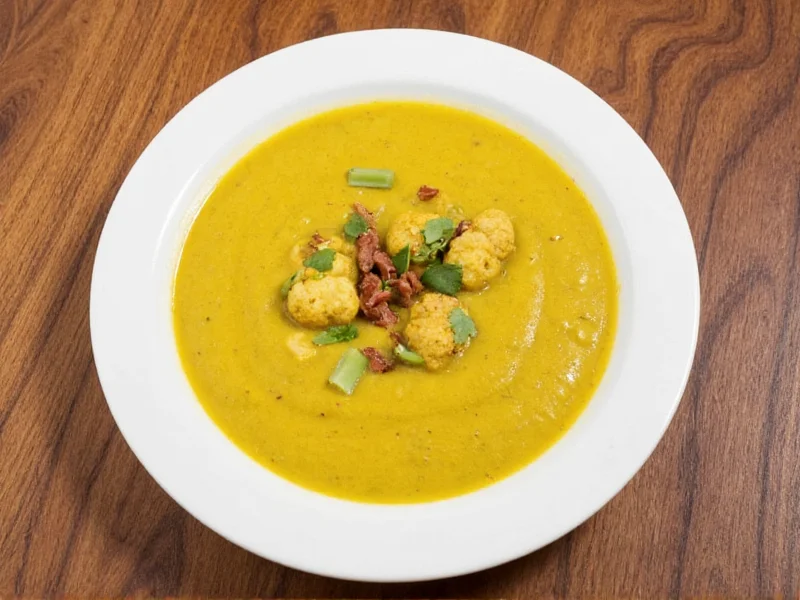Curried cauliflower soup has surged in popularity as a versatile comfort food that satisfies diverse dietary needs without compromising on flavor. This vibrant yellow dish transforms humble cauliflower into a velvety masterpiece through the magic of spice-infused broth and proper blending technique. Unlike traditional cream-based soups, this dairy-free alternative achieves luxurious texture through the cauliflower's natural starches, making it perfect for vegan, paleo, and gluten-free diets.
The Essential Components of Perfect Curried Cauliflower Soup
Creating exceptional curried cauliflower soup requires understanding how each element contributes to the final dish. The quality of your curry powder significantly impacts flavor depth—homemade blends typically outperform store-bought versions. Freshly toasted spices release essential oils that dried powders alone can't replicate. When selecting cauliflower, choose heads with tight, creamy-white florets and bright green leaves, indicating peak freshness and maximum flavor potential.
Step-by-Step Preparation Guide
Begin by preparing your spice base: heat coconut oil in a large pot over medium heat, then add finely chopped onions and sauté until translucent. Incorporate minced garlic and ginger, cooking for one minute until fragrant. Add your curry powder blend (a combination of turmeric, cumin, coriander, and a pinch of cayenne), stirring constantly for 30 seconds to bloom the spices.
Next, add the cauliflower florets and vegetable broth. Bring to a gentle boil, then reduce heat and simmer uncovered for 15-20 minutes until the cauliflower pierces easily with a fork. Proper cooking time is crucial—undercooked cauliflower won't blend smoothly, while overcooking diminishes its nutritional value. For enhanced flavor complexity, consider adding a splash of apple cider vinegar or lemon juice during the final minutes of cooking.
| Ingredient | Quantity | Substitution Options |
|---|---|---|
| Cauliflower | 1 large head (about 2 lbs) | Broccoli (for different flavor profile) |
| Coconut milk | 1 can (13.5 oz) | Cashew cream, silken tofu, or additional broth |
| Curry powder | 2-3 tbsp | Homemade blend of turmeric, cumin, coriander |
| Vegetable broth | 4 cups | Water with additional seasoning |
Advanced Techniques for Flavor Enhancement
Professional chefs often employ several techniques to elevate basic curried cauliflower soup. Roasting the cauliflower before adding to the broth develops complex caramelized flavors through the Maillard reaction. For an umami boost, incorporate a teaspoon of miso paste or a strip of kombu seaweed during simmering. The addition of toasted cashews or almonds before blending creates a richer mouthfeel that mimics dairy cream without actual dairy.
Texture refinement separates good soup from exceptional soup. After blending, pass the soup through a fine-mesh sieve to eliminate any fibrous bits, resulting in restaurant-quality smoothness. For optimal flavor integration, allow the soup to rest for at least 30 minutes before serving—this resting period lets the spices fully permeate the cauliflower base.
Customization Options for Dietary Preferences
This versatile recipe adapts beautifully to various dietary requirements. For a lower-fat version, reduce or eliminate the coconut milk and increase broth volume while adding a quarter-cup of raw cashews before blending. Those following a nightshade-free diet can replace standard curry powder with a blend of turmeric, cumin, coriander, and black pepper. To increase protein content, stir in cooked lentils or chickpeas after blending.
Spice levels can be precisely controlled to suit individual preferences. Mild versions work well for children or sensitive palates, while adding fresh Thai chilies or extra cayenne creates a fiery experience for heat enthusiasts. Consider offering toppings like cilantro, toasted coconut flakes, or a drizzle of chili oil to let each diner customize their bowl.
Storage and Reheating Best Practices
Curried cauliflower soup maintains excellent quality when stored properly. Cool the soup completely before transferring to airtight containers, leaving one inch of headspace for expansion if freezing. Refrigerated soup stays fresh for 4-5 days, while frozen portions remain quality for up to three months. When reheating, add a splash of broth or water as the soup thickens upon cooling.
For meal prep efficiency, portion the soup into single servings before freezing. Thaw overnight in the refrigerator for best results, then gently reheat on the stove over medium-low heat. Avoid boiling when reheating, as high temperatures can cause separation and diminish flavor complexity.
Nutritional Benefits and Health Considerations
Curried cauliflower soup delivers impressive nutritional benefits. A single serving provides approximately 150-200 calories, making it suitable for weight management plans. The cauliflower base offers significant vitamin C (73% of daily value), vitamin K (20% DV), and fiber (10% DV). Turmeric's active compound, curcumin, provides anti-inflammatory properties enhanced by black pepper's piperine.
This soup serves as an excellent vehicle for increasing vegetable consumption, particularly for those who struggle with traditional vegetable preparations. The creamy texture appeals to children and adults alike, making it a strategic choice for introducing more plant-based meals into regular rotation. For individuals managing blood sugar, the low glycemic index and high fiber content help maintain stable glucose levels.
Conclusion
Mastering curried cauliflower soup opens doors to endless culinary creativity within healthy eating parameters. This adaptable recipe serves as both comforting meal and nutritional powerhouse, satisfying diverse palates while accommodating multiple dietary restrictions. By understanding the science behind flavor development and texture refinement, home cooks can consistently produce restaurant-quality results that impress even discerning eaters. Whether enjoyed as a light lunch, elegant starter, or hearty main course with appropriate additions, this vibrant soup deserves regular rotation in any health-conscious kitchen.











 浙公网安备
33010002000092号
浙公网安备
33010002000092号 浙B2-20120091-4
浙B2-20120091-4